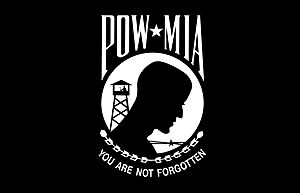National League of POW/MIA Families facts for kids

|
|
| Established | May 2, 1970 |
|---|---|
| Founder | Sybil Stockdale |
| Founded at | Constitution Hall, Washington, D.C. |
| Type | 501(c)(3), humanitarian organization |
| Headquarters | 5673 Columbia Pike, Suite 100, Falls Church, Virginia |
The National League of Families of American Prisoners and Missing in Southeast Asia is often called the National League of POW/MIA Families. It's a special group in America that helps families of soldiers missing from the Vietnam War. This group is also known simply as the League.
Its main goal is to find out what happened to American soldiers who went missing during the Vietnam War. This includes getting any prisoners released. They also work to find and bring home the remains of those who died serving their country. The League's most famous symbol is its flag.
The League has a main office in Falls Church, Virginia. It has a few full-time workers and many volunteers. Today, 1,575 U.S. service members are still listed as missing from the Vietnam War. The U.S. government and the National League of Families continue to work together. They want to find out what happened to these missing soldiers. The League keeps pushing both Washington and Hanoi (Vietnam's capital) for answers. They want to bring peace to the families of those still missing.
How the League Started
The National League of POW/MIA Families began with groups formed in 1966. Sybil Stockdale and other wives of missing soldiers started these groups. They were in Coronado, California. Sybil Stockdale's husband, Navy Commander James Stockdale, was shot down in 1965. She wanted Americans to know that U.S. prisoners of war (POWs) were being treated badly.
Later, Evelyn Grubb joined because she was frustrated. She felt the government was not giving enough information. These groups helped convince the U.S. government to change its approach. This happened in 1969. The National League of Families officially became a national group in 1967. It was later set up in Washington, D.C., on May 28, 1970.
Another important member of the League was Joe McCain. He is the brother of John McCain, who was a U.S. Navy pilot and later a U.S. Senator. The League became more well-known in 1972. Life Magazine published a big article about the group. The article showed a photo of Major Wilmer Newlin Grubb. He was Evelyn Grubb's husband. He had been shot down in 1966 and taken prisoner.
Evelyn Grubb also worked as the League's representative. She spoke to the White House, the United Nations, and at the Paris Peace Talks. She pushed for better care and a quick return for American POWs and MIAs. She also worked for better policies for their families. Evelyn Grubb found out after the war that her husband had died soon after being shot down.
In the 1980s, a new group was formed. It was called the National Alliance Of Families For the Return of America's Missing Servicemen. This group split off from the National League of Families. They disagreed with the League's president, Ann Mills Griffith. They had different ideas about how to reach their goals. They also disagreed about the status of missing soldiers in the 1980s. The National Alliance takes a stronger, more active approach. They especially believe that some "live prisoners" might still be in Southeast Asia.
The POW/MIA Flag
The famous National League of Families' POW/MIA flag was created in January 1972. Evelyn Grubb, who was then the League President, helped make it happen. The first design for the flag was made by artist Newt Heisley in 1971. This was for Annin Flagmakers. Mary Hoff, whose husband was missing, saw the need for a symbol.
Evelyn Grubb also worked hard to get the flag adopted. The military, the U.S. Postal Service, and other government groups started using it. Over time, the flag became very popular. It became a national symbol to remember the Vietnam War.
The flag has the words "You Are Not Forgotten, POW/MIA." This message is now widely recognized. You can still see the flag flying in many places today. It flies in front of all U.S. post offices. It is also at major U.S. military bases. Most fire stations, police stations, and many state agencies fly it too. Most veterans' groups across the United States also display it. The flag is almost always present at veterans' events. Millions of Americans see this flag every day.
More to Learn
- Defense Prisoner of War/Missing Personnel Office
- Joint POW/MIA Accounting Command
- List of United States servicemembers and civilians missing in action during the Vietnam War (1961–65)
- List of United States servicemembers and civilians missing in action during the Vietnam War (1966–67)
- List of United States servicemembers and civilians missing in action during the Vietnam War (1968–69)
- List of United States servicemembers and civilians missing in action during the Vietnam War (1970–71)
- List of United States servicemembers and civilians missing in action during the Vietnam War (1972–75)
- Vietnam War POW/MIA issue

